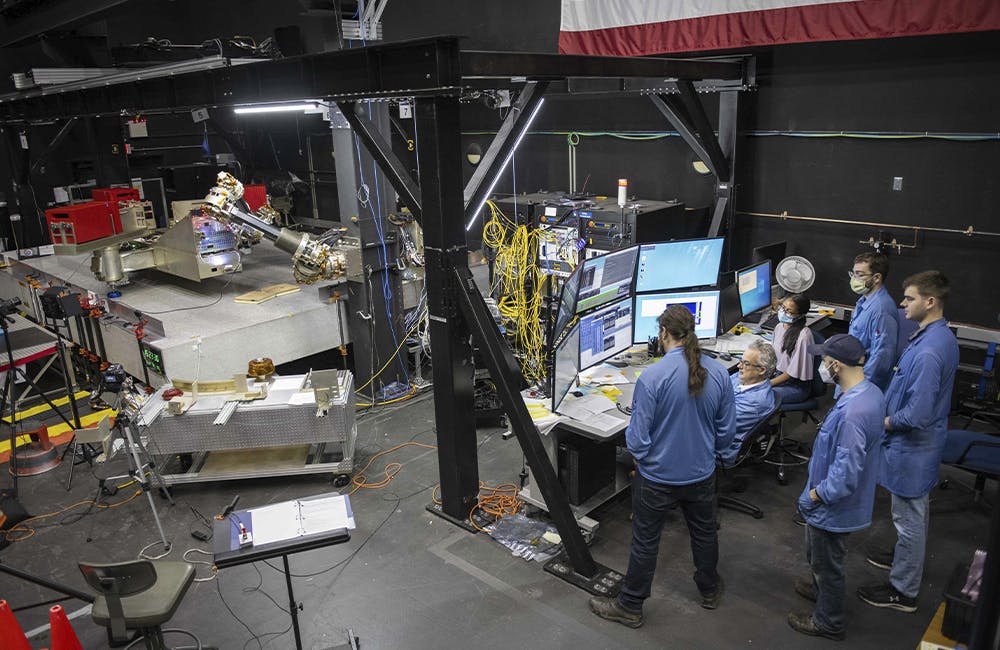Navy Wants Robots to Perform Routine Shipboard Tasks
The Naval Research Laboratory has been building robots to perform ship maintenance and repair fragile and expensive satellites to help sailors prioritize mission needs.

The U.S. Navy may soon get robots to perform routine maintenance and janitorial tasks on Navy ships — alleviating the burden of monotonous and sometimes dangerous tasks for sailors and improving the efficiency of the service’s assets.
With funding from the Office of Naval Research, the U.S. Naval Research Laboratory’s (NRL) Naval Center for Space Technology (NCST) is building a robot that can perform routine tasks such as mopping decks, repainting, doing dishes, folding laundry, inspecting electrical panels and even looking for leaks. The assistance will allow sailors to focus more on the mission.
“All of the standard things that you need to do to have a ship operate, but those tasks are secondary to the ship’s primary purpose, which is to fight naval battles,” Glen Henshaw, head of robotics and machine learning in the lab’s Naval Center for Space Technology, told GovCIO Media & Research. “The more that we can have robots do the routine maintenance tasks, the more we can have the sailors do the job that only sailors could do, and maybe have fewer sailors in harm’s way when they do actually need to fight.”
The lab initially wanted to build a small four-legged robot that would provide Marines with better intelligence, surveillance and reconnaissance capabilities, including inspecting a building without sending a human inside or navigating an outdoor terrain. But the Office of Naval Research became more interested in how the technology could be used aboard ships. Henshaw’s team has been focusing on that aspect for the past three years.
Teaching a robot to interact with various objects around them effectively the way humans do with their hands every day without thinking about it is highly complex, and it is referred to in robotics as the “manipulation problem.”
“It’s very hard to build a robot that can do the dishes or fold the laundry. It’s hard enough just to get a robot that can open a door and walk through it, much less … handling objects that are really flexible or really fragile,” Henshaw said. “Those are the kinds of things that we would like robots to do onboard ships. And so we are applying types of machine learning to try to get robots to learn how to do those manipulation tasks.”
Solving the manipulation problem for the robot to be able to perform tasks such as grasping, lifting or placing items requires a combination of various processes, such as path planning, also known as motion planning and artificial intelligence techniques.
“[Robots] can’t really learn how to do motor tasks by us explaining them. They have to practice, so that’s a kind of AI called reinforcement learning. And we’re working very heavily with that,” Henshaw said.
Over the past 10 years, the open-source community has released high-quality software toolkits for AI, allowing laboratories interested in doing the type of work Henshaw’s team does to have a starting point with good software. Doing something innovative, however, requires writing more software on top of the software that’s publicly available.
“We try to embed software engineers in all of our groups because having a software engineer that both understands software, but also understands robotics and mathematics, and all of those sorts of specific issues to making software drive a device — those folks are really rare and very valuable,” Henshaw said.
To help potentially train AI developers, the Navy is looking to leverage generative AI systems and large language models without compromising data security.
“We have completed research on using large language models to convert Navy documents into executable agents,” David Aha, director of the Navy Center for Applied Research in Artificial Intelligence, told GovCIO Media & Research. “Specifically, we used a fine-tuned version of GPT-3 to generate code from documentation samples, and evaluated these code samples for their quality and accuracy. We expect that this system could be used to tutor AI developers and, if given sufficient training samples, directly convert technical documents into executable agents.”
Another initiative is a collaboration with the Defense Advanced Research Projects Agency (DARPA) and Northrop Grumman called the Robotic Servicing of Geosynchronous Satellites (RSGS) program, which aims to build a robotic arm that repairs in-orbit satellites.
Currently planned for a 2024 launch, the program would revolutionize what can be accomplished in space. Satellites are fragile and expensive, and while some software issues can be easily resolved, most mechanical problems cannot be fixed, reducing their lifespan to only a couple of years.
“We’re finishing up the software, where we’re bolting everything together and very rigorously testing it to make sure that it’s going to work in space the way that it works on the ground,” Henshaw said.
For the lab, focusing on robotics and AI advancements overall has profound impacts.
“We’ll continue to work on AI and ML because it affects everything,” Steven Meier, director of the Naval Center for Space Technology, told GovCIO Media & Research.
This is a carousel with manually rotating slides. Use Next and Previous buttons to navigate or jump to a slide with the slide dots
-

Trump's Return to Office Sparks Focus on AI Infrastructure
A potential AI czar and prior AI executive orders lead to new considerations for R&D and energy infrastructure.
7m read -

VA Focuses on Continuous Improvement for 2025 EHR Rollout
VA plans to resume rollout of its EHR in FY 25, focusing recent feedback to drive continuous improvement amid the presidential transition.
4m read -

Trump's Intelligence Pick Backs Cybersecurity, Tech Accountability
The former congresswoman has called for improving cyber defenses and advocated for accountability in federal tech and data practices.
2m read -

DHS Leads Government’s Largest Civilian AI Hiring Effort
On this AI GovCast miniseries, Boyce discusses his journey to the agency with his prior roles at the Office of Management and Budget.
15m listen








